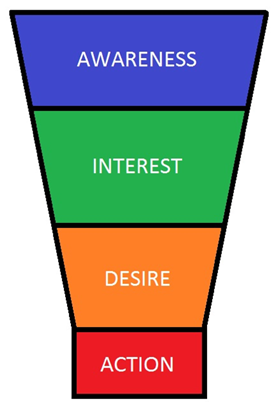Key performance indicators (KPIs) are essential to our industry. Without them, we’re like a pilot without navigation; we have no idea if what we’re doing is getting us closer to our goal. They’re the barometers of success which show whether or not your client is making money or losing money.
KPIs are set based on your client’s primary goal (revenue, leads, etc.). However, not all PPC campaign types acquire the same type of user; some campaigns are designed to target users who are ready to buy while others are designed to target users who’ve never heard of your client’s business before.
It goes to reason, then, that adjusting your KPIs according to the goal of a given campaign can be a better barometer for success and contribute more to the overall success of your PPC account and your client’s business.
Using the Marketing Funnel to Assign KPIs
The goal of this post is to provide you a different way of analyzing your campaigns so you can do your job as a PPC strategist better. To do this, I’m going to turn to the ever-present marketing funnel which outlines a user’s journey in the most basic of terms:

The top of the funnel represents a user who is unaware of your client’s business and the bottom of the funnel represents a user who has converted. Hence, a high funnel user is less likely to convert than a low funnel user. Easy enough, yeah?
What you may not realize yet is that each of these sections in the marketing funnel (read: each of these user types) typically correspond with a PPC campaign type: branded search, non-branded search, hard remarketing, soft remarketing, and display. Your KPIs shouldn’t necessarily be uniform across each campaign type because the success of a given campaign depends on what type of user it’s acquiring.
Let’s go through each section of the funnel and learn what KPIs you should be focusing on.
High Funnel User
User Level: Awareness
A high funnel user is just becoming aware of your client’s business and isn’t necessarily interested in what they have to sell. This type of user isn’t searching for anything related to your client’s business.
Campaign Type: Display
The only way this user goes from unaware to aware is through an initial point of contact outside of search. This type of user is acquired through banner ad or video ad display campaigns (non-remarketing).
Focus: On-Site Usage Metrics
This user is unlikely to convert on their first visit. If your account’s average cost per acquisition (avg. CPA) is $50, don’t be surprised to see an avg. CPA 20 or 30 times higher for these campaigns specifically. You want this user to engage with the content on your client’s website so they become interested in what they have to sell. Therefore, success of these campaigns should be determined by on-site usage metrics.
High Funnel Key Performance Indicators
- Bounce Rate
- Avg. Session Duration
- Pages per Session
Mid Funnel User
User Level: Interest
A mid funnel user is aware of your client’s business and is becoming more interested in their offer(s). They may be actively searching for related topics in an effort to learn more and/or see what offers competitors have.
Campaign Type: Non-Branded Search, Soft Remarketing
This type of user is typically acquired through non-branded search campaigns, which contain terms that signify said user is problem-aware and/or solution-aware. Furthermore, this user tends to convert well with soft remarketing campaigns. These campaigns offer this user additional content to assist them down the funnel instead of a hard sell right away.
Focus: New User Conversion Metrics, Assisted Conversion Metrics
These users do tend to convert, but at lower rates than the account or site average. When this is taken into account, these campaigns can best be judged off of new user conversion metrics; these more accurately reflect a mid funnel user. Furthermore, since these campaigns are also designed to get a mid funnel user to return to your client’s site later and convert as a low funnel user, assisted conversion metrics can also be effective at judging the success of these campaigns.
Mid Funnel Key Performance Indicators
- New User Conversion Volume
- New User Conversion Rate
- New User Avg. CPA
- New User ROAS (if e-commerce)
- Assisted Conversion Volume
- Assisted Conversion : Last-Click Conversion Ratio
Low Funnel User
User Level: Desire
A low funnel user is well aware of your client’s business, possibly searching for your client specifically, and is as ready to convert as they’ll ever be.
Campaign Type: Branded Search, Hard Remarketing
This type of user is typically acquired through branded search campaigns; they’re more likely to search for a specific brand and convert. Likewise, they’re more likely to be ready for a hard sell and convert from a remarketing ad which is offering them a specific product or service.
Focus: Returning User Conversion Metrics
These users will convert at higher rates than any other type of user. As such, focusing on returning user conversion metrics, particularly on a last click model, will be the best way to measure the success of these campaigns.
Low Funnel Key Performance Indicators
- Returning User Conversion Volume
- Returning User Conversion Rate
- Returning User Avg. CPA
- Returning User ROAS (if e-commerce)
Use Campaign Labels
Ensuring each campaign you’re running fits into this methodology can be a bit cumbersome at first. However, once your campaign structure is set up appropriately, it’s easy to filter campaigns for user type by using campaign labels. These labels will allow you to analyze data based on what part of the marketing funnel you’re focused on. Likewise, filtering campaigns using these labels will make using different sets of KPIs relatively easy and organized.
Final Thoughts
A campaign can only be as successful at achieving your client’s end goal (i.e. more revenue) as the type of user it acquires. You can optimize a brand awareness display campaign until there’s nothing left to adjust; it will never convert as well as a branded search campaign because it’s more likely to acquire a top funnel user.
Remember: Every single user passes through the marketing funnel. Understanding that journey and knowing where each of your campaigns fit into the marketing funnel is essential to running the most efficient and successful PPC account possible.



